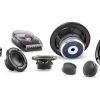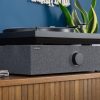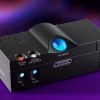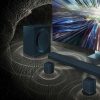The term Dynamic Range is used in both video and audio. In video, Dynamic Range is the “distance” between the darkest and brightest areas of a displayed image(s). For more details on the video aspect of dynamic range in video, read our companion article: WTF is HDR? In this article, we discuss the nature of dynamic range in audio.
In audio, Dynamic Range is the ratio of the loudest undistorted sound produced in relation to the softest sound that is still audible. Dynamic Range is measured using the Decibel Scale.

Dynamic Range and Decibels
Decibels are a logarithmic scale of relative loudness. A difference of approximately 1 dB is the minimum change in volume that is perceptible, a 3 dB difference reflects a moderate change in volume, and a difference of about 10 dB is perceived as a doubling of volume.
Here is how loud sounds are in nature measured using the Decibel Scale:
- Whisper: 15 to 25 dB
- Natural ambient sound: 35 dB
- Normal home or office background: 40 to 60 dB
- Normal speaking voice: 65 to 70 dB
- Orchestral climax: 105 dB
- Live rock music: 120 dB+
- Pain threshold: 130 dB
- Jet aircraft: 140 to 180 dB
Within that scale, one dB is the smallest difference in loudness that can be detected by a functioning human ear.
For example, the difference between a whisper and a rock concert can be as much as 120 dB (when listening at the same distance). This means that a rock concert is 10 billion times louder than a whisper.
For recorded music, a CD can accommodate an audio signal with up to 100 dB of dynamic range, while a vinyl record tops out at about 65 dB. However, although a CD, vinyl record, or other analog and digital audio sources can accommodate a specific dynamic range, it ultimately boils down to how the audio content is mixed, or in the case of TV and radio shows they are broadcast, that determines the dynamic range you actually hear.
When live music is recorded and mixed to a recording medium for the disc, streaming, download, or broadcast, the person mixing the sound uses compression to alter the dynamic range of the original performance by decreasing and increasing the loundness levels of the sound elements to achieve a specific listening effect. However, the thing to keep in mind is that it is usually more desirable when the recorded sound has a dynamic range of the original live sound. The provides more accuracy and texture to the music, TV, or movie soundtrack.
If music is poorly mixed, a vocal may appear to be drowned out by the background instruments, and in movies, the dialog may be too soft to understand.

Dynamic Range in Music
When it comes to recorded music, Pop, Rock, R&B, hip-hop, and country music typically have a narrow dynamic range of around 10 dB. Electronic dance music (EDM) typically has the most narrow dynamic range (sometimes as little as 6 dB).
Tip: TV commercials also have a very narrow dynamic range, this is what makes them sound louder that the rest of the TV or movie content which is recorded with a wider dynamic range. This is why TV commercials are perceived as being louder.
Jazz has a wider dynamic range of about 20dB or wider. Sound ranges from loud passages from brass and woodwind instruments to piano and bass that are not as loud.
In recorded music, classical music performances have the widest dynamic range. Listening to a live symphony orchestra performance, the dynamic range may be as wide as 90 dB. Since vinyl records don’t support that wide a dynamic range, the sound mixer needs to narrow (compress) the dynamic range.
On the other hand, there are cases where it might be desirable on playback to further change the dynamic range of an audio recording or live broadcast beyond the provided sound mix to suit a specific listening situation. One example of this is the difference in the audio experience in theatrical cinemas vs home theater.

Dynamic Compression
In addition to how Dynamic Range is implemented when live content is recorded and mixed, it can also be manipulated on the playback side by the listener using an option known as Dynamic Compression.
This capability allows a listener to change the relationship between the loudest and quietest parts of a content source when played back.
For example, if explosions or sound effects are too loud in relation to the dialog, you can narrow the dynamic range of the sound signal so that the dialog is closer to the same level as the explosions/sound effects. This makes the overall sound more even. This is especially useful when playing a CD, DVD, Blu-ray Disc, streaming, or broadcasting content at low volume when lower frequencies typically fall off in loudness level in relation to other frequencies.
Some devices that may include the ability to implement Dynamic Compression include AV receivers, soundbars, and all-in-one home theater systems. Depending on the brand/model of the device, the Dynamic Compression feature may be labeled as follows:
- Dynamic Range
- DRC
- Accuvoice (ZVOX)
- Clear Voice
- D Comp
- Dolby Volume
- Dynamic Volume
- Speech or Speech Clarity
- Night Mode
- Voice Adjust
- Volume Leveling
Tip: In some cases, Dynamic Compression may not only be implemented to adjust the dynamic range of specific content but also across different sources, such as when changing TV channels. In this scenario, all the channels are heard at the same volume level.
Dolby Volume Demo
Dynamic Range vs Signal-to-Noise Ratio
Dynamic Range is sometimes confused with Signal-to-Noise Ratio (aka S/N or SNR). However, the difference is that SNR refers to the ratio of an audio signal to noise that is not a part, of the audio signal whereas Dynamic Range refers to the ratio of the loudest and softest parts of an audio signal. To dig deeper into the topic of Signal-to-Noise Ratio, read our companion article: WTF is Signal-to-Noise Ratio (SNR)?

Related Reading













































Luis
August 1, 2024 at 1:56 pm
Constructive criticism from a long-time audiophile: Why use “WTF” ?? I use vulgar language. myself when appropriate for effect, I’m not a prude – BUT it just looks bad in print..lessens my feelings about the publication…and is poor PR for our audiophile hobby.